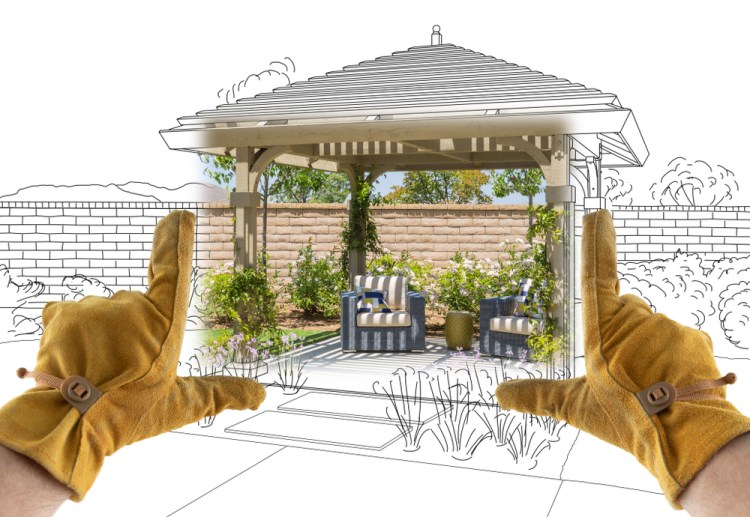DIY Landscape Design
Want to DIY your landscape design? Novices can do many elements of the process on their own. These include:
Determining your style
The first step in landscape design is to identify your style. Do you prefer a formal or informal garden? Do you want a modern or traditional look? Consider the architectural style of your home and choose a landscape style that complements it. Find images of gardens, hardscapes, decks, and outdoor living spaces that you like, and create a collage with an online platform like Pinterest or the traditional way, from cut-and-pasted magazine photos.
Creating a rough sketch
Draw a rough sketch of your yard or garden, including the dimensions of your space. Indicate the location of any existing trees, shrubs, or other plants. This will help you visualize your design and make changes before planting.
Choosing plants
Choose plants suitable for your climate and soil type. Consider the colors, textures, and heights of the plants you select. You can also mix in annuals and perennials for various blooms throughout the year. Add these to your sketch to start filling out your plan.
Planning outdoor living spaces
Decide what features you want in your outdoor living spaces, such as a patio, deck, fire pit, or brick oven. What are the most important functions you want to include, such as seating, dining spaces, or outdoor cooking? You can select furniture and easily install items like a portable fire pit.
Leave It to the Pros
Professional landscapers bring expertise, including training and experience, to your project. Hiring a professional can save you time, money, and stress by managing the project from start to finish and handling any unexpected issues. They can also offer creative new ideas and approaches you have yet to consider to help you achieve a unique and personalized landscape design.
These include:
Conducting a site analysis
A professional landscape designer conducts a site analysis to determine the soil type, drainage, sun exposure, irrigation, and other factors that affect your landscape design. They may consider whether your area is prone to natural disasters such as fires or flooding and include ideas for mitigation. They’ll also troubleshoot any hazardous areas or current trees or shrubs that need care.
Develop a master plan
A master plan is a detailed plan that outlines the design of your landscape, including plant selections, hardscaping, lighting, and outdoor living spaces. This plan will help ensure that your landscape is cohesive and functional. A master plan can assist in breaking up the entire project into smaller steps according to your budget.
Refining plant choices and materials
A professional designer will be more experienced at selecting plants and materials appropriate for your climate and soil type. They will also consider the maintenance requirements of each plant and material. Plus, they often have access to discounts or bulk rates.
Provide construction supervision
Consider hiring a professional if your landscape design includes hardscaping or other construction elements such as a brick oven or installed fire pit. A professional designer will supervise the construction process to ensure it is completed according to the design plan. They may have people within their company who can do the work or have referrals to ones they know and trust.
Budget management
A professional landscape designer can help you manage your budget effectively by making informed decisions about plant selections, hardscape materials, and other design elements. They can also help you prioritize your spending to ensure you get the most value from your investment.
Handle issues
As with any home maintenance project, sometimes unexpected issues arise. Professional landscape designers can plan for problems with drainage, pests, or soil. They can take responsibility for obtaining the required permits and ensuring your project complies with local codes.
Property value and sustainability
If your landscape goals include increasing your property value or creating an environmentally friendly yard, landscape designers can help achieve those goals. A well-designed landscape can significantly increase the value of your property, and a professional designer can help you create a landscape that enhances your home’s curb appeal and makes the most of your outdoor space. They can also create a sustainable landscape that is low-maintenance with native plants that require less water.
Ready to Hire a Landscape Designer?
Finding a landscape design professional can be daunting, but there are several ways to go about it. Ask for referrals from friends, family members, or neighbors who have recently had landscaping work done. Visit local home and garden shows or garden centers and ask staff for recommendations. Or check professional associations such as the Association of Professional Landscape Designers (APLD) or the American Society of Landscape Architects (ASLA) to find nearby professionals.
Landscape design is essential to creating a beautiful and functional outdoor space. While there are some things that homeowners can do themselves, hiring a professional landscape designer can ensure that your design is cohesive, functional, and sustainable. A professional designer can provide a wide range of services, from site analysis to ongoing maintenance, to help you achieve your landscape goals and save you time, money, and frustration in the long run.
Comments are not available on this story.
Send questions/comments to the editors.


